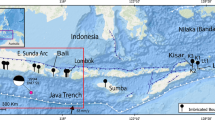Abstract
Large longitudinal bedforms (comet marks) occur on the current-swept shelf off southeast Africa. They emanate from tight clusters of low rock outcrops and are as long as 135 m and as wide as 30 m. The low length/width ratio (1:4.5) is explained by lateral coalescence of several narrow tails associated with individual obstacles. They seem to form by removal of sediment from the wake region of the obstacles. Hydrodynamic considerations indicate a high probability for sonic suspension transport, yet no sand shadows occur in the velocity-defect region of the inner wake. It is concluded that shear velocities must exceed the minimal velocity required to sustain sediment transport.
Similar content being viewed by others
References
Werner F, Newton RS (1975) The pattern of large-scale bedforms in the Langeland Belt (Baltic Sea). Marine Geology 19:29–59
Werner F, Unsöld C, Koopman B, Stefanon A (1980) Field observations and flume experiments on the nature of comet marks. Sedimentary Geology 26:233–262
Flemming BW (1980) Sand transport and bedform patterns on the continental shelf between Durban and Port Elizabeth (Southeast African Continental Margin). Sedimentary Geology 26:179–205
Newton RS, Seibold E, Werner F (1973) Facies distribution patterns on the Spanish Sahara continental shelf mapped with side-scan sonar. “Meteor” Forschungsergebnisse (Reihe C) 15:55–77
Stride AH, Belderson RH, Kenyon NH (1972) Longitudinal furrows and depositional sand bodies of the English Channel. Mémoire du Bureau de Recherches Geologiques et Minieres 79:233–240
Dyer KR (1970) Linear erosional furrows in Southamptom water. Nature 255:56–58
Flood RD, Hollister CD (1980) Submersible studies of deepsea furrows and transverse ripples in cohesive sediments. Marine Geology 36:MJ-M9
Coleman JM, Prior DB, Adams CE (1981) Erosional furrows on the continental shelf edge, Mississippi delta region. Geo-Marine Letters 1:11–15
Allen JRL, (1982) Sedimentary Structures. Their Character and Physical Basis, II. Amsterdam: Elsevier
Open University (1978) Oceanography, Unit 11. Introduction to Sediments. Walton Hall, England: Open University, pp. 1–22
Graf WH, Acaroglu ER (1966) Settling velocities of natural grains. Bulletin fo the International Association of Hydrological Sciences 11:27–43
Pearce AF (1976) The gross features of the east coast shelf circulation. Council for Scientific and Industrial Research (South Africa) Research Report 346:1–18
Author information
Authors and Affiliations
Rights and permissions
About this article
Cite this article
Flemming, B. Giant comet marks. Geo-Marine Letters 4, 113–115 (1984). https://doi.org/10.1007/BF02277081
Received:
Revised:
Issue Date:
DOI: https://doi.org/10.1007/BF02277081




